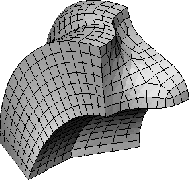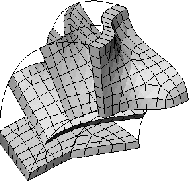
engineering & technology publications
ISSN 1759-3433
PROCEEDINGS OF THE FIFTH INTERNATIONAL CONFERENCE ON ENGINEERING COMPUTATIONAL TECHNOLOGY
Generation of Semi-Structured Meshes over Generalized Extruded Volumes
Department of Mechanics, Faculty of Civil Engineering, Czech Technical University in Prague, Czech Republic
The most simple one-to-one extruded shape is formed by sweeping a trimmed surface along a control curve. This implies that the topology of such a volume is defined by a pair of cap surfaces on its top and bottom sides which are linked together by a set of lateral surfaces. In this work, a quite complex class of extruded volumes, operating with cap surfaces that are identical topologically but not geometrically is considered. This implies several significant features. First of all, the cap surfaces may be of different area, shape and curvature. Moreover, a single common control curve describing the extrusion does not exist. The sweep trajectory is uniquely defined only for those boundary vertices of the cap surfaces that correspond to appropriate sides (in the sweeping direction) of lateral surfaces.
The standard procedure to generate an extruded semi-structured mesh consists of the following steps: 1) identify the source and target cap surfaces, 2) generate an appropriate unstructured surface mesh over the source surface, 3) generate a valid surface mesh over the target surface that is topologically identical with the source mesh, 4) generate a valid structured quadrilateral mesh over lateral surfaces compatible with the cap surfaces, 5) generate a valid volume mesh inside the extruded volume. With respect to the sweeping methodology, the most specific algorithms are related to steps 1, 3, and 5. The mesh generation in steps 2 and 4 can be performed by ordinary structured and unstructured surface mesh generation techniques. However it is important to mention that the quality of source and lateral surface meshes has usually a great impact on the quality of the resulting volume mesh.
For steps 2 and 4, a mapping method based on Bernstein polynomials is adopted in this study. The mapping between the parametric spaces of source and target surfaces is approximated by a Bezier surface of appropriate order. Points of the control polygon of that surface are determined by means of a least-squares fit between the parametric coordinates of corresponding boundary nodes on the source and target surfaces. Since the intermediate layers of nodes are not described by a surface parameterization, this approach cannot be directly applied to the generation of volume interior nodes. Instead, the extruded volume is approximated by a Bezier volume of appropriate order. Its control polygon points are again determined by a least-squares fit but this time applied to all the boundary nodes of the extruded volume. Because neither from the mappings defined by the Bezier surface and by the Bezier volume is exact, the surface mesh on the target surface as well as the final volume mesh are subjected to appropriate smoothing.
The capabilities of the proposed and implemented sweeping algorithm are presented using a number of examples. One of them, a semi-structured mesh generated over a general extruded volume, is depicted in Figure 1.
purchase the full-text of this paper (price £20)
go to the previous paper
go to the next paper
return to the table of contents
return to the book description
purchase this book (price £105 +P&P)

